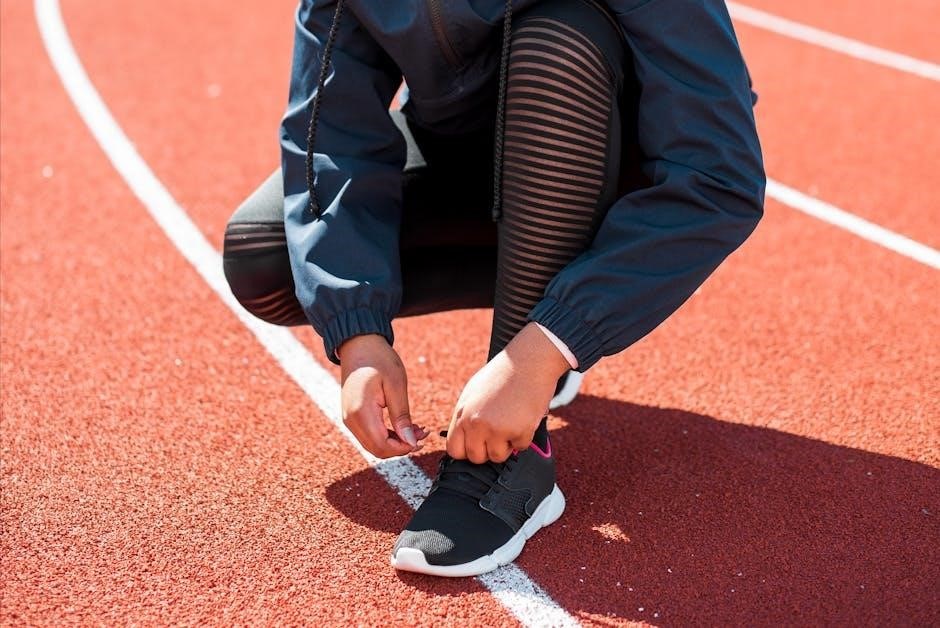A proper running shoe fit is crucial for comfort, performance, and injury prevention. This guide helps you understand key aspects like toe box space, heel snugness, and sizing to ensure a perfect fit for your runs.
Key Components of a Proper Fit
A proper fit involves a snug heel, comfortable midfoot, and adequate toe box space. Ensure correct sizing and avoid tight or loose areas for optimal comfort and support.
Toe Box Fit
A proper toe box fit is essential for comfort and performance. The toe box should provide enough space for your toes to wiggle freely, with about a thumb’s width between your longest toe and the shoe’s end. A snug but not tight fit ensures minimal friction and prevents blisters. The material should allow natural toe movement, while the shape should align with your foot’s anatomy. Too tight a fit can cause discomfort, while too loose may lead to sliding during runs. Ensuring adequate toe box space is critical for maintaining balance and avoiding foot fatigue during long runs.
Midfoot and Heel Fit
A proper midfoot and heel fit ensures stability and prevents slipping during runs. The midfoot should feel snug but not constricting, while the heel should fit securely without excessive movement. A thumb’s width of space between the heel and the shoe’s back is ideal. Improper fit in this area can lead to discomfort, blisters, or even injuries. When trying on shoes, walk or jog to ensure the heel stays in place and the midfoot feels supported. This balance is crucial for optimal performance and comfort during your runs.
Proper Sizing and Space
Proper sizing and space are essential for a comfortable and injury-free running experience. Your running shoes should provide a thumb’s width of space between your longest toe and the shoe’s end to allow natural toe movement. The shoe should feel snug but not tight, with the heel and midfoot securely held in place. A common recommendation is to opt for a half size larger than your street shoe size to accommodate foot swelling during runs. Avoid shoes that feel too loose, as this can lead to blisters and instability. Proper sizing ensures optimal performance and comfort, making it a critical factor in your running shoe fit.

How to Determine Your Running Shoe Size
Measure foot length and width accurately, ideally in the afternoon when feet are slightly swollen. Use a ruler or measuring tape for precise dimensions.
Measuring Foot Length
Accurately measuring foot length is essential for a proper fit. Stand or sit with your foot flat on the floor. Place a ruler under the heel and measure to the tip of the longest toe. This ensures a precise length. Add about half a size to accommodate foot swelling during runs. For a quick check, ensure a thumb’s width of space between your longest toe and the shoe’s end. This method helps avoid tightness and discomfort. Proper measurement is the foundation for selecting the right size and ensuring comfort during workouts.
Measuring Foot Width
Measuring foot width is essential for ensuring a proper fit. Stand on a flat surface with your feet slightly apart, using a ruler or foot measuring device. Mark the widest point across the ball of your foot, just behind the toes. Repeat for both feet, as they may differ slightly. Use this measurement to determine your shoe width, considering options like narrow, standard, or wide. Accurate width measurement helps prevent discomfort and ensures optimal support during runs. Always try shoes in the afternoon, as feet tend to swell throughout the day, ensuring the best fit.
Trying On Running Shoes
Try shoes in the afternoon, as feet swell during the day. Wear running socks and ensure a snug, comfortable fit with room for toe movement and proper heel alignment.
Best Time to Try On Shoes
The best time to try on running shoes is later in the day, as feet tend to swell throughout the day. This ensures a comfortable fit even during long runs. Visit a specialty running store where staff can assess your gait and foot shape. Wear the same type of socks you plan to run in, as this affects fit. Allow enough time for a proper fitting, including a short walk or run to gauge comfort. A well-timed visit ensures you find shoes that feel great from the start, reducing the risk of discomfort or injury during your runs.
Importance of Wearing Running Socks
Wearing running socks during shoe try-ons ensures a more accurate fit, as they provide cushioning and moisture-wicking properties. Proper socks can prevent blisters and discomfort during runs. They also help maintain the shoe’s shape, ensuring the fit isn’t too tight or loose. Running socks are designed to manage sweat, reducing slippage and irritation. Trying shoes without them may lead to a less-than-ideal fit, as regular socks can cause shoes to feel tighter or looser. Always opt for high-quality, breathable socks to enhance comfort and performance. This step is essential for achieving the best fit and maximizing your running experience.

Common Mistakes to Avoid
Common mistakes include buying shoes too tight or loose, not considering foot shape, and ignoring proper sizing. Avoid these errors for optimal comfort and performance during runs.
Buying Too Tight or Too Loose
Buying running shoes that are too tight can cause discomfort, blisters, and restrict toe movement, while shoes that are too loose may lead to instability and poor performance. A proper fit ensures snugness in the heel and midfoot, with adequate wiggle room in the toe box. Many runners make the mistake of choosing shoes based on their casual shoe size, which often differs. To avoid this, try shoes on in the afternoon, as feet tend to swell during the day. Use the thumb width test to ensure there’s enough space between your longest toe and the shoe’s end. Proper sizing is key to comfort and performance.
Not Considering Foot Shape
Ignoring your foot shape can lead to poor fit and discomfort. Flat feet, high arches, or narrow/wide feet require specific shoe features. For instance, flat feet need supportive shoes, while high arches benefit from cushioning. Narrow feet may need a snugger fit, and wide feet require a roomier toe box. Neglecting foot shape can cause blisters, poor support, or even injuries. Always consider your foot type when selecting shoes to ensure proper alignment and comfort during runs. This step is crucial for optimizing performance and preventing long-term foot issues.

Signs of a Proper Fit
A proper fit features a snug heel and midfoot, with enough room for toes to wiggle. Ensure a thumb’s width between your longest toe and the shoe’s end for optimal comfort and performance.
Snug Heel and Midfoot
A snug fit in the heel and midfoot ensures stability and prevents excessive movement during runs. The heel should feel secure without feeling tight, while the midfoot should provide a firm yet comfortable grip. This support helps maintain proper foot alignment and reduces the risk of blisters or discomfort. A well-fitting heel and midfoot also contribute to better energy efficiency, allowing for a smoother running experience. Ensure the shoe isn’t too tight, as this can restrict blood flow, but it should hold your foot firmly in place to avoid slipping during strides.
Adequate Toe Wiggle Room
Adequate toe wiggle room is essential for a comfortable fit. Your toes should have enough space to move freely without feeling cramped. A good rule of thumb is to ensure there’s about a half-inch of space between your longest toe and the shoe’s end. This prevents blisters, toe jamming, and discomfort during runs. While the toe box should feel roomy, it shouldn’t be so loose that your foot slides around. Proper toe space promotes natural foot movement and reduces the risk of toenail issues. Always check this when trying on shoes to ensure a balanced fit that supports performance and comfort.
How to Check Shoe Fit
A proper fit ensures comfort and prevents injuries. Use the thumb width test and fold the shoe to check for adequate space and snugness without tightness.
The Thumb Width Test
To ensure proper toe fit, perform the thumb width test. Stand upright and press your longest toe against the shoe’s front. There should be a space of about a thumb’s width between your toe and the shoe’s end. This allows for natural toe movement without constriction. If the space is too small, the shoe may cause discomfort or blisters. Conversely, excessive space can lead to foot sliding during runs. This test helps verify adequate wiggle room, ensuring a balance between comfort and support. Additionally, folding the shoe can provide further insight into its flexibility and fit, complementing the thumb width test.
Folding the Shoe
To check the fit, hold the shoe upright and cup your palm around the heel. Gently fold the toe back toward your arm. If the shoe creases visibly near the ball of the foot, it indicates proper flexibility and fit. This test ensures the shoe isn’t too stiff or too loose, providing the right balance of support and comfort during runs. A shoe that folds naturally aligns with your foot’s movement, reducing the risk of blisters or discomfort; This simple technique helps confirm if the shoe meets your fit requirements.
Foot Type and Fit
Your foot type influences shoe fit. Flat feet may need more arch support, while high arches require cushioning. Narrow or wide feet need appropriate widths for comfort.
Flat Feet and Fit
For runners with flat feet, proper shoe fit is essential to provide adequate support and stability. Flat feet often require shoes with stronger arch support and motion control features to prevent overpronation. The shoe should have a sturdy heel counter and a responsive midsole to reduce strain on the feet. Additionally, ensuring enough toe box space is crucial to avoid discomfort. A snug yet comfortable fit in the midfoot and heel helps stabilize flat feet during runs. Opting for shoes designed for flat feet can enhance performance and reduce the risk of injuries. Proper fit ensures balanced support and comfort for runners with flat feet.
High Arches and Fit
Runners with high arches often need shoes that provide sufficient support and cushioning to prevent discomfort. High arches can lead to excessive pressure on the ball and heel of the foot. A proper fit ensures the shoe accommodates the arch without compressing it. Look for shoes with firmer midsoles or motion control features to stabilize high arches. Adequate toe box space is also crucial to avoid putting extra pressure on the toes. When trying on shoes, ensure the arch support aligns with your foot’s natural curve. This balance helps maintain comfort and performance during runs, reducing the risk of injuries like plantar fasciitis.
Narrow or Wide Feet
Runners with narrow feet may find certain shoes too roomy, while those with wide feet often struggle with tight fits. For narrow feet, opt for shoes with a snug midfoot and heel to prevent slipping. For wide feet, choose models with a roomier toe box to avoid pressure. Some brands offer wide or narrow versions of their shoes, so check availability. Additionally, consider the shoe’s width when trying them on—ensure there’s no excessive tightness or looseness. A proper fit for both foot types ensures comfort and prevents issues like blisters or discomfort during runs. Always test shoes in the afternoon, as feet tend to swell slightly during the day.

Pronation and Fit
Pronation affects how your foot rolls during running. Neutral, overpronation, or underpronation require specific shoe support. Proper fit ensures stability, reducing injury risks and enhancing performance.
Neutral Pronation
Neutral pronation occurs when the foot rolls inward naturally during running, distributing impact evenly. Runners with this gait benefit from shoes offering balanced cushioning and support. Proper fit ensures the shoe complements this movement, preventing discomfort or injury. A snug heel and midfoot, with adequate toe space, are ideal. Avoid overly supportive or minimalist designs unless necessary. Neutral pronation allows for a wide range of shoe options, but ensuring the shoe aligns with your foot’s natural motion is key for optimal performance and comfort during runs.
Overpronation
Overpronation occurs when the foot rolls inward excessively during running, often leading to discomfort or injury. Runners with overpronation benefit from shoes with motion control or stability features to correct foot alignment. These shoes typically have stiffer materials in the midfoot and heel to reduce inward rolling. Proper fit ensures the shoe provides enough support without feeling too rigid; Overpronation can cause issues like plantar fasciitis or shin splints if not addressed, making the right shoe choice crucial for long-term comfort and performance. Ensuring a snug yet comfortable fit in the midfoot and heel is essential to counteract overpronation effectively during runs.
Underpronation
Underpronation, also known as supination, occurs when the foot rolls outward during running, placing stress on the ankle and outer foot. Runners with underpronation benefit from shoes with extra cushioning and a more flexible sole to absorb impact. Proper fit is crucial, as underpronation can lead to discomfort or injury if the shoe doesn’t provide adequate support. Shoes designed for underpronation often feature neutral or cushioned designs without excessive stability features. Ensuring the toe box has enough space prevents pressure on the toes, while a snug midfoot and heel provide stability. The right fit helps reduce the risk of ankle strain and enhances overall running performance.
Break-In Period
A proper break-in period for running shoes ensures comfort and prevents discomfort or injury. New shoes should be gradually introduced to your routine, starting with short runs or walks. This allows the materials to mold to your foot shape and reduces the risk of blisters or hotspots. During the break-in, pay attention to any areas of pressure or tightness, as these can indicate a poor fit. Properly broken-in shoes will feel snug yet comfortable, providing the right balance of support and flexibility. Avoid wearing them for long distances initially, as this can lead to discomfort. A gradual transition ensures optimal performance and longevity of the shoes.

When to Replace Running Shoes
Knowing when to replace your running shoes is essential for maintaining comfort and performance. Most shoes last between 300-500 miles or 3-6 months, depending on usage. Look for signs like excessive wear on the soles, flattened cushions, or a noticeable loss of support. If your shoes feel less responsive or cause discomfort, it’s time for a new pair. Pay attention to your body—increased fatigue or new aches may indicate worn-out shoes. Replace them promptly to prevent injuries and ensure optimal performance during runs. Tracking your mileage or setting reminders can help you stay on top of replacement schedules.
